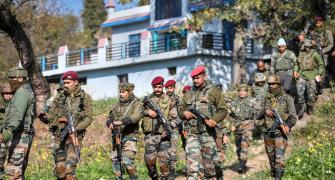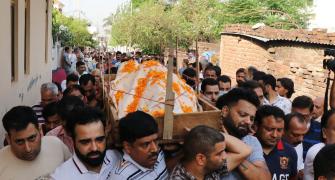'Terrorists who are active in Poonch and Rajouri are not relying on random locals for logistics, guidance etc.'
'They are being supported by a selected few who are being vetted, cleared and directed from across the LoC.'

Lieutenant General Paramjit Singh Sangha, former deputy chief of the army staff (strategy), has had a wide, varied and long experience of serving in Jammu and Kashmir.
In his 39 years of service in the Indian Army, the officer of the elite Parachute Regiment (Special Forces) has spent about 20 years in all ranks and various assignments in J&K -- from second lieutenant to lieutenant general.
He commanded a Special Forces battalion and was a key planner of the surgical strikes in 2016 as chief of staff of the Northern Command.
The general also headed the prestigious and strategic XVI Corps, responsible for southern Pir Panjal, the Line of Control and the internal/external security challenges in the Jammu region.
In long years of service in J&K, he participated in several high profile operations from the siege of the Harzratbal mosque in 1993, the kidnapping of Western tourists by Al-Faran in 1995 and countering the agitation after the killing of terrorist Burhan Wani.
With an in-depth knowledge of the terrain, demography, culture of J&K and dynamics of the volatile LoC and counter infiltration activity, General Sangha shares his informed view about the recent increase in terrorism in the Poonch-Rajouri sector.
The area had been cleared of terrorists by a dogged and sustained effort by the Indian Army, but there has been a spurt of terrorism that has claimed the lives of 34 security personnel since 2021.
Nineteen soldiers were killed in four attacks by the terrorists in Rajouri and Poonch in 2023, PTI reported. However, the security forces eliminated more than 30 terrorists in the two districts last year, both on the Line of Control as well as in the hinterland.
After the December 21 attacks, Home Minister Amit Shah called a high level meeting to discuss the security situation, attended by National Security Adviser Ajit K Doval, Chief of Army Staff General Manoj C Pande, J&K Lieutenant Governor Manoj Sinha among others.
In an interview to Rediff.com's Archana Masih, General Paramjit Singh Sangha speaks about the unique challenges of countering terrorists in the mountainous jungles, the narco-smuggler nexus that abets terrorism and measures that can strengthen security in the area.
What have been your own personal experiences of serving in J&K (both as a senior and junior commander)?
The experience in J&K has been wide and varied across various commands and staff assignments from 1983 to 2019 at different periods both on the Line of Control and internally north and south of the Pir Panjal range and in all districts of J&K except the International Border sector.
It was a professionally challenging experience because a dynamic security situation in J&K demands that leaders at all levels remain prepared for the least expected.
As junior leader the task is straightforward -- 'to lead soldiers in combat to eliminate terrorists'.
The role broadens and becomes complex at the mid/senior level -- 'to formulate and implement Counter Proxy War Strategy' to defeat Pakostan sponsored terrorism.
The security situation in Jammu and Kashmir has been dynamic. In my opinion, newer hot spots could emerge wherever 'operational space' is available to the terrorists to gravitate.
However, in this changing security situation, two factors have remained constant.
a. Pakistan continues to pursue sponsoring terrorism through her proxies as a State policy.
b. Security forces in Jammu & Kashmir, specially the Indian Army, have continued to function with utmost dedication and zeal and made repeated sacrifices to bring stability and calm to the region.
In a situation of temporary setbacks, the security forces have shown resolve to bounce back and get on top of the situation.

Drawing from your wide and rich operational experience, what advice would you have for young officers who have faced reverses and loss of soldiers in the Poonch-Rajouri sectors recently?
Junior leaders are the pride of the Indian Army. They have proved their mettle in combat time and again. Despite reverses they are launching operations to seek contact. This itself, speaks volumes of their valour and commitment.
I am confident that they are doing what they are good at -- learn honest lessons, take corrective measures and bounce back with greater resolve.
While doing the above, I would ask them to be mindful of:
a. Unlike conventional operations in counter-insurgency/counter-terrorism ops, you are not bound by timelines. Avoid rushing in, be deliberate, time is on your side.
b. The Indian Army's basic tactics, operational techniques and battle procedures are time tested. Avoid deviations.
c. The local population in the Poonch/Rajouri areas in the past has helped security forces to turn the situation and bring peace. Avoid antagonising them.
In the Poonch/Rajouri areas, a strong counter-infiltration grid is in place and is effective. However, there always is a possibility of a few terrorists slipping in.
In addition, the lower altitudes along the Line of Control are prone to exploitation for narcotics and weapons smuggling.

Till two years ago, the Poonch-Rajouri area was peaceful and had been cleaned of terrorists by the Indian Army.
What in your opinion emboldened terrorists that has resulted in the deaths of several soldiers last year?
The region has witnessed a cycle of violence in the past, both in the depth areas and along the Line of Control.
As recently as early 2020, the LoC was active. High intensity ceasefire violations, raids on posts, ambushes, mutilation of bodies was happening. Whereas, the depth areas were calm and incident free for a long time.
In my opinion, the Poonch and Rajouri areas have been activated by design. Probably the number of terrorists is not large, but they have fool-proof communication with handlers across the LoC who coordinate their logistics and provide operational directions.
Terrorists in Poonch and Rajouri to my mind are not dependent on locals, therefore HUMINT [human intelligence] is void.
Why has this area been re-activated:
a. The counter terrorism grid is not as thick in Kashmir after troops were relocated to the Line of Actual Control.
b. The terrorists who were existing and lying dormant, know the area. The terrain favours them and Pakistan wants to keep the pot boiling, probably below our threshold level.

What are some of the time-tested and dependable 'on the ground, old-style' techniques of jungle warfare that need to be followed to strengthen security in the area?
The jungles pose additional challenges for the conduct of operations. Mountains with jungles further compound the problems.
Visibility is restricted, so is the field of fire and engagement ranges. Area weapons like mortars and rocket launchers, MMGs [Medium Machine Guns] etc are less effective.
The logistics, casualty evacuation, movement of reserves is time consuming.
The range of communication sets reduce and helicopters/drone support is difficult.
The jungle terrain is favourable for small team ops and the one who knows the jungle can use it to his advantage.
In my opinion, terrorists in Poonch and Rajouri are operating from hideouts within the jungle. Their presence and movements are concealed; they carry out an incident and melt back. They periodically change hideouts and leave no tell-tale signs.
Operations involving large body of troops is prone to detection, ambushes, IED etc. Cordon and search or seek and destroy operations can result in casualties and fatigue to troops.
Troops trained to operate in small teams, self-contained for a protracted period, and who are able to conceal their presence are more effective in the jungles.
They can be in the jungle, watch activity, choose the time and place and strike. Ops like ambushes and raids are more successful in jungles.
Although basic training to soldiers includes some aspects of operations in jungles and the same is further refreshed during pre-induction training -- however, limited training only serves limited purpose. It meets the requirement of clearing small patches during ops with fire support to avoid casualties.

Do you feel that human intelligence and basic jungle warfare soldiering plays a greater role than electronic surveillance/intelligence when it comes to securing the LoC?
While the troop deployment along the LoC is to maintain the sanctity of the LoC, a strong anti-infiltration obstacle is in place to deny infiltration.
Deployment on the LoC includes obstacles in the form of a formidable fence with a surveillance system, various kinds of sensors, cameras (day and night) and the LoC is manned by troops with weapons with day/night visions.
All aspects are important. While technology is an enabler to improve efficiency and operational effectiveness of soldiers, training and proficiency of soldiers to use the ground to their advantage is equally important.
However, overreliance on technology and ignoring human aspects is fraught with dangers.

Has the intelligence network among the Bakharwals weakened and is this one of the reasons for the increase in terrorist activity?
The Bakharwals and Gujjars of the Poonch and Rajouri area played a key role in improving the security situation. They stood up against the terrorists, assisted the Indian Army in clearance of Hill Kaka the so-called 'liberated area'.
They have supported the Indian Army in the past; they do it now, and in my opinion, will continue to do so.
In my opinion, the increase in terrorist incidents is not because the Bakharwals and Gujjars are not providing information. These terrorists who are active in Poonch and Rajouri are not relying on random locals for logistics, guidance etc. They are being supported by a selected few who are being vetted, cleared and directed from across the LoC.

Jammu and Kashmir Lieutenant Governor Manoj Sinha, COAS General Manoj C Pande and Northern Army Commander Lieutenant General Upendra Dwivedi are also seen. Photograph: ANI Photo
In the December 21 ambush, terrorists had positioned themselves on hill tops and chose a blind curve on the road to target army vehicles.
This shows how well-informed they were about the terrain.
Could you throw some light on the ecosystem that exists between terrorists, smugglers and local informants that enables such attacks?
It's true that the terrorists selected an ambush site from where they could cause maximum damage and make a quick getaway.
This indicates that they have received training from the Pakistan army. Also without guidance as recce, a copy book style action is difficult to execute.
They surely would have received support and information from some over-the-ground workers who could freely move around and inform them of troop movement, numbers, timings, etc.
In my opinion, it is the narco-smuggler nexus that is providing support.

Why has terrorist activity increased in this area while it has reduced in Srinagar and other parts of the Kashmir Valley?
It is surely by design and directions from across the LoC. Probably to keep the pot boiling, they have chosen a favourable area.
In Srinagar, as compared to Poonch and Rajouri, operations can be launched in a faster time-frame due to the terrain and thick counter-terrorism deployment.
The flow of information to local police and Indian Army is more due to the density of population.
The narco-smuggler nexus, supported through tactical drones, is strong in the Poonch and Rajouri region.
Also, handlers are able to directly communicate with terrorists and selected over-the-ground workers without use of communication systems that can be intercepted and monitored.
Also, due to relocation of forces to the Line of Actual Control, the already thin deployment has further depleted.

National Security Advisor Ajit K Doval, Lieutenant Governor Manoj Sinha and General Manoj C Pande are also seen. Photograph: ANI Photo
What are some of the measures required so that peace returns to Poonch-Rajouri sector again?
Repeated incidents in Poonch and Rajouri is a matter of concern. Sacrifices made to bring peace to this area cannot be allowed to go in vain.
I am confident the Northern Command has taken a very serious view and collective measures are underway.
While local formations will honestly draw lessons, make required corrections in operational techniques, battle procedures and drills, they will also deploy additional resources under their command and revisit training curriculum focussing on intelligence aspects.
Some other measures that need to be considered are:
a. Deny operational space to the terrorists by deploying additional troops from outside the command theatre.
b. Counter infiltration grid in this area is strong, however an audit to identify weak spots and plug them is required.
c. Infusion of hi-tech equipment to improve operational effectiveness of the troops is urgently required. These include anti-drone systems, foliage penetration radars, precision strike tactical drones, communication interception equipment etc.
d. Securing of lines of communication by forces other than the Indian Army needs to be considered.
This will deny terrorists freedom of movement in vehicles from across the Poonch and Rajouri and from the International Border sector side.
e. The nexus between narco/smugglers and terrorists needs to be neutralised on priority. There is a requirement to go after the big players in the business rather than small time drug peddlers. This task cannot be left to local security forces/agencies, but a multi-agency effort at a higher level would yield results.
f. Right sizing of forces/drawing down of the Rashtriya Rifles needs to be reconsidered, especially in the light of commitment on the LAC and requirement of more boots on the ground in counter-insurgency/counter-terrorism.
g. Lastly, handlers across the LoC should also feel the heat. They cannot sit in safe sanctuaries and perpetuate violence.
A strong message to Pakistan that there cannot be business as usual on the LoC when depth areas are being targeted.
Feature Presentation: Aslam Hunani/Rediff.com










